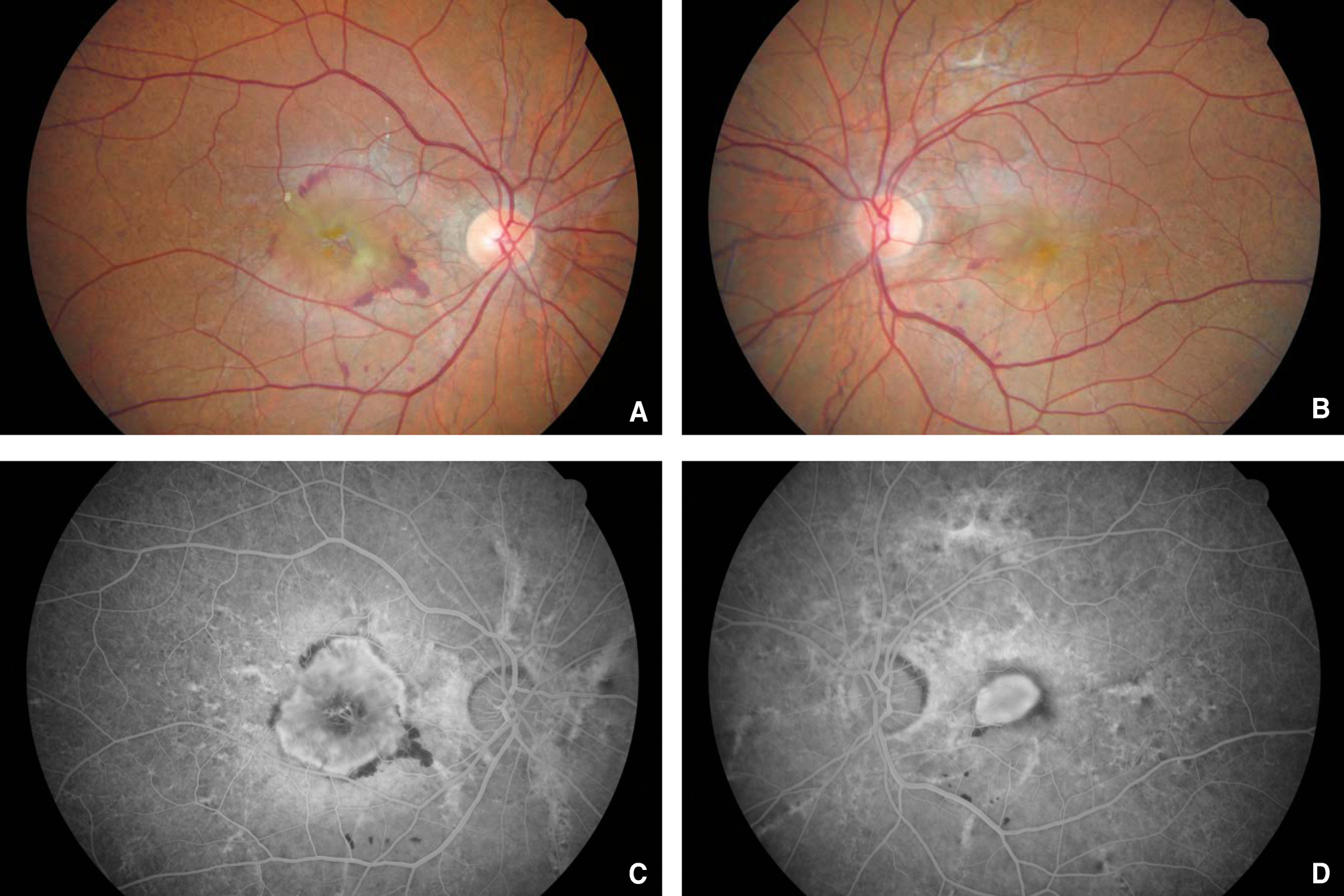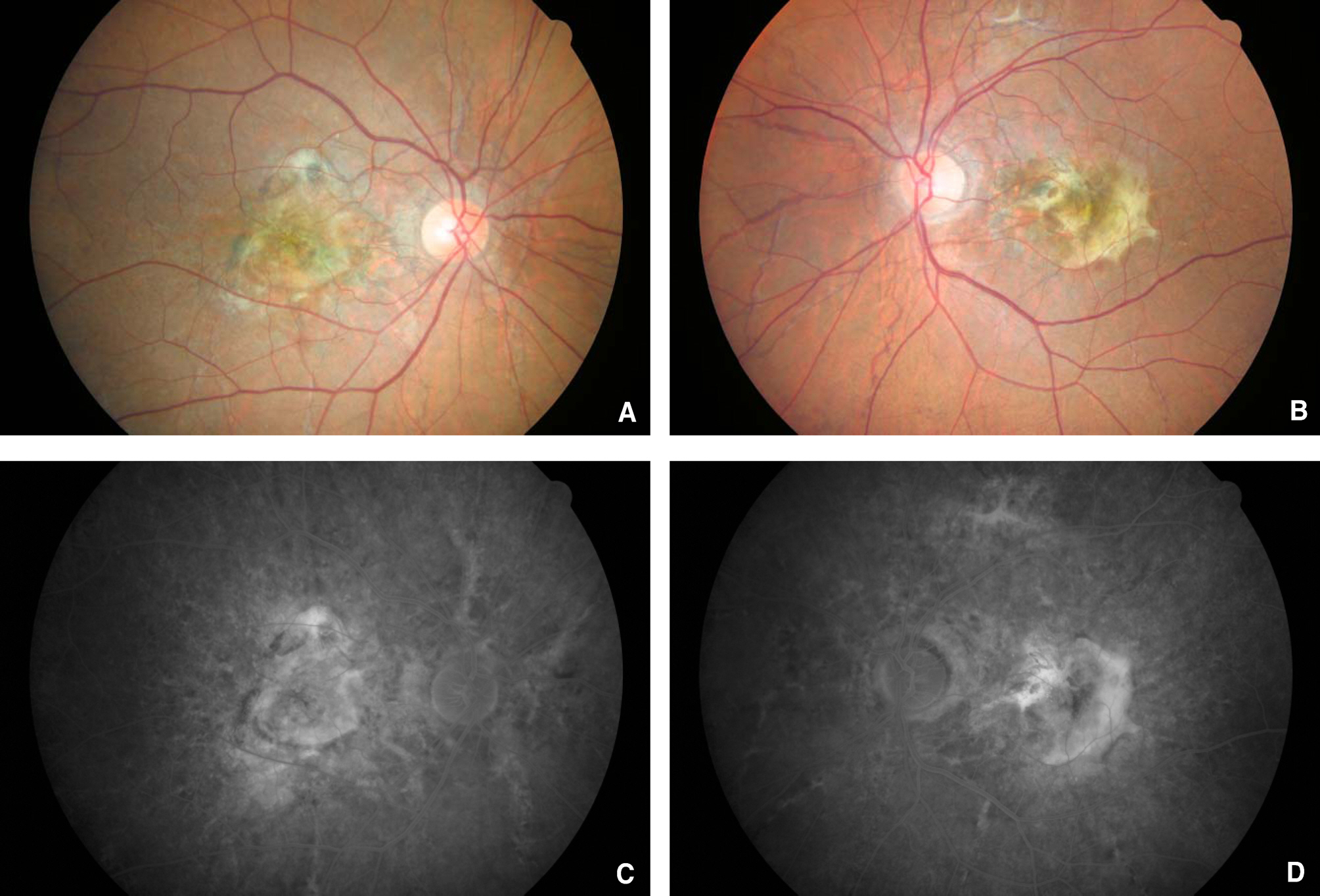J Korean Ophthalmol Soc.
2007 Nov;48(11):1593-1598.
Photodynamic Therapy for Choroidal Neovascularization in Angioid Streaks
- Affiliations
-
- 1Myung-Gok Eye Research Institute, Department of Ophthalmology, Konyang University, Kim's Eye Hospital, Seoul, Korea. eyecure@hotmail.com
Abstract
-
PURPOSE: To evaluate the efficacy of photodynamic therapy (PDT) with verteporfin in the management of choroidal neovascularization (CNV) associated with angioid streaks.
CASE SUMMARY
Six eyes of four patients with CNV due to angioid streaks were treated with photodynamic therapy with verteporfin. Visual acuity testing, ophthalmologic examinations, photographs, and fluorescein angiograms were used to evaluate the results of PDT. Two of six eyes had subfoveal lesions, while four eyes had juxtafoveal lesions on initial examination. Conversion from a CNV to a fibrous scar lesion following PDT was observed in four eyes. Enlargement of the CNV was documented in two eyes at the final follow-up. Of a total of 6 eyes, the final best-corrected visual acuity decreased in 4 eyes and stabilized in 2 eyes.
CONCLUSIONS
Photodynamic therapy can achieve short-term cessation or decrease of fluorescein leakage from chroidal neovascularization associated with angioid streaks. However, it does not alter the course of this disease, and multiple sessions are needed. Visual prognosis is poor.
Keyword
MeSH Terms
Figure
Reference
-
References
1. Mansour AM, Ansari NH, Shields JA, et al. Evolution of angioid streaks. Ophthalmologica. 1993; 207:57–61.
Article2. Shields JA, Federman JL, Tomer TL, Annesley WH Jr. Angioid streaks. I. Ophthalmoscopic variations and diagnostic problems. Br J Ophthalmol. 1975; 59:257–66.
Article3. Piro PA, Scheraga D, Fine SL. Management of retinal vascular and macular disorders. 1st ed.1. Baltimore: Williams & Wilkins;1983. p. 136–9.4. Sickenberg M, Schmidt-Erfurth U, Miller JW, et al. A preliminary study of photodynamic therapy using verteporfin for choroidal neovascularization in pathologic myopia, ocular histoplasmosis syndrome, angioid streaks, and idiopathic causes. Arch Ophthalmol. 2000; 118:327–36.
Article5. TAP Study Group. Photodynamic therapy of subfoveal choroidal neovascularization in age-related macular degeneration with vertephrfin: one-year results of 2 randomized clinical trials. TAP Report 1. Arch Ophthalmol. 1999; 117:1329–45.6. Macular Photocoagulation Study Group. Five-year follow-up of fellow eyes of individuals with ocular histoplasmosis and unilateral extrafoveal or juxtafoveal choroidal neovascularization. Arch Ophthalmol. 1996; 114:677–88.7. Piro PA, Scheraga D, Fine L. Management of retinal vascular and macular disorders. 1st ed.1. Baltmore: Williams & Wilkins;1983. p. 136–290.8. Clarkson JG, Altman RD. Angioid streaks. Surv Ophthalmol. 1982; 116:414–23.
Article9. Gelisken O, Hendrikse F, Deutman AF. A long-term follow-up study of laser coagulation of neovascular membranes in angioid streaks. Am J Ophthalmol. 1988; 105:299–303.
Article10. Pece A, Avanza P, Galli L, Brancato R. Laser photocoagulation of choroidal neovascularization in angioid streaks. Retina. 1997; 17:12–6.
Article11. Roth DB, Estafanous M, Lewis H. Macular translocation for subfoveal choroidal neovascularization in angioid streaks. Am J Ophthalmol. 2001; 131:390–2.
Article12. Husain D, Kramer M, Kenny AG, et al. Effects of photodynamic therapy using verteporfin on experimental choroidal neovascularization and normal retina and choroids up to 7 weeks after treatment. Invest Ophthalmol Vis Sci. 1999; 40:2322–31.13. Sickenberg M, Schmidt-Erfurth U, Miller JW, et al. A preliminary study of photodynamic therapy using verteporfin for choroidal neovascularization in pathologic myopia, ocular histoplasmosis syndrome, angioid streaks, and idiopathic causes. Arch Ophthalmol. 2000; 118:327–36.
Article14. Treatment of Age-Related Macular Degeneration With Photodynamic Therapy (TAP) Study Group. Verteporfin Therapy for Subfoveal Choroidal Neovascularization in Age Related Macular Degeneration Three Year Results of an Open Label Extension of 2 Randomized Clinical Trials-TAP Report No 5. Arch Ophthalmol. 2002; 120:1307–14.15. Karacorlu M, Karacorlu S, Ozdemir H, et al. Photodynamic therapy with verteporfin for choroidal neovascularization in atients with angioid streaks. Am J Ophthalmol. 2002; 134:360–6.16. Browning AC, Chung AK, Ghanchi F, et al. Verteporfin photodynamic therapy of choroidal neovascularization in angioid streaks: one-year results of a prospective case series. Ophthalmology. 2005; 112:1227–31.17. Shaikh S, Ruby AJ, Williams GA. Photodynamic therapy using verteporfin for choroidal neovascularization in angioid streaks. Am J Ophthalmol. 2003; 135:1–6.
Article18. Chung AK, Gauba V, Ghanchi FD. Photodynamic therapy using verteporfin for juxtafoveal choroidal neovascularization in angioid streaks associated with pseudoxanthoma elasticum: 40 months results. Eye. 2005; 20:629–31.
- Full Text Links
- Actions
-
Cited
- CITED
-
- Close
- Share
- Similar articles
-
- A Case of Photodynamic Therapy of Juxtafoveal Choroidal Neovascularization in Angioid Streaks
- Photodynamic Therapy With Verteporfin for Choroidal Neovascularization in Patients with Angioid Streaks
- A Case of Intravitreal Bevacizumab Injection for the Treatment of Choroidal Neovascularization in Angioid Streaks
- Fluorescein Study of Angioid Streaks with Pseudoxanthoma Elasticum
- A Case of Angioid Streaks Associated with Pseudoxanthoma Elasticum



